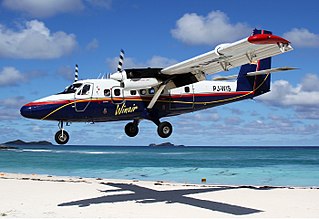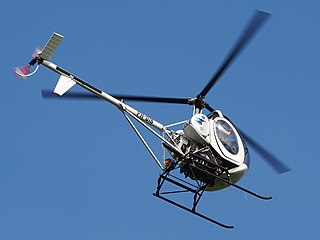This is a list of aviation-related events from 1977, This is the year of the second-deadliest air disaster in history, the Tenerife airport disaster. Here are the aviation events of 1977:

The de Havilland Canada DHC-6 Twin Otter, currently marketed as the Viking Air DHC-6 Twin Otter, is a Canadian 19-passenger STOL utility aircraft developed by de Havilland Canada and currently produced by Viking Air. The aircraft's fixed tricycle undercarriage, STOL capabilities, twin turboprop engines and high rate of climb have made it a successful commuter passenger airliner as well as a cargo and medical evacuation aircraft. In addition, the Twin Otter has been popular with commercial skydiving operations, and is used by the United States Army Parachute Team and the United States Air Force's 98th Flying Training Squadron.

The de Havilland Canada DHC-3 Otter is a single-engined, high-wing, propeller-driven, short take-off and landing (STOL) aircraft developed by de Havilland Canada. It was conceived to be capable of performing the same roles as the earlier and highly successful Beaver, including as a bush plane, but is overall a larger aircraft.

New York Airways was a helicopter airline in the New York City area, founded in 1949 as a mail and cargo carrier. On 9 July 1953 it may have been the first scheduled helicopter airline to carry passengers in the United States, with headquarters at LaGuardia Airport. Although primarily a helicopter airline operator with scheduled passenger operations, New York Airways also flew fixed wing aircraft, such as the de Havilland Canada DHC-6 Twin Otter 19-passenger STOL twin turboprop aircraft.

West Coast Air was a Canadian scheduled airline operating de Havilland Canada DHC-6 Twin Otter float planes, which was integrated into Harbour Air Seaplanes.

Kenn Borek Air is an airline based in Calgary, Alberta, Canada. It operates regional passenger and cargo services, contract operations in the Arctic and Antarctic and aircraft leasing. Its main base is at Calgary International Airport. It charters aircraft for scientific expeditions, oil exploration, etc., and operates air ambulance services.

Air Vegas was an airline with its headquarters on the grounds of the North Las Vegas Air Terminal in North Las Vegas, Nevada. It operated daily sightseeing flights from Las Vegas to the Grand Canyon. Prior to moving to the North Las Vegas Airport its main bases were McCarran International Airport (LAS), Las Vegas and Henderson Executive Airport (HND), Las Vegas.

Grand Canyon National Park Airport is a state-owned public-use airport located in Tusayan, Arizona. A CDP in unincorporated Coconino County, Arizona, United States. It is near Grand Canyon National Park, 7 miles from the South Rim of the Grand Canyon. The airport is primarily used for scenic tours and charter flights, but there is scheduled commercial service.
Grand Canyon Airlines is a 14 CFR Part 135 air carrier headquartered on the grounds of Boulder City Airport, Boulder City, Nevada, United States. It also has bases at Grand Canyon National Park Airport and Page Municipal Airport, both in Arizona. It operates sightseeing tours and charter service over and around the Grand Canyon. Its headquarters and main operation center is Grand Canyon National Park Airport and Boulder City Airport, Nevada. The company slogan is With Grand Canyon Airlines, Your Memories are Cleared for Takeoff!

Tenzing–Hillary Airport, also known as Lukla Airport, is a domestic airport and altiport in the town of Lukla, in Khumbu Pasanglhamu, Solukhumbu District, Province No. 1 of Nepal. It gained worldwide fame as it was rated the most dangerous airport in the world for more than 20 years by a program titled Most Extreme Airports, broadcast on The History Channel in 2010.

Los Angeles Airways Flight 841 was a Sikorsky S-61L helicopter that crashed at 5:50 p.m. on Wednesday May 22nd 1968 in the city of Paramount, California. All twenty passengers and three crewmembers were killed. The aircraft was destroyed by impact and fire. The probable cause of the accident was a mechanical failure in the blade rotor system, which then allowed one blade to strike the side of the fuselage. The other four blades were then thrown out of balance and all five rotor blades broke and then the rear fuselage and tail separated from the rest of the airframe. The cause of the mechanical failure is undetermined. At the time, it was the worst helicopter-related accident in U.S. aviation history, not to be surpassed until the 1986 Grand Canyon mid-air collision which killed 25.

Golden West Airlines Flight 261, a De Havilland Twin Otter DHC-6, collided with a Cessna 150 (N11421), owned by CessnAir Aviation, Inc., near Whittier, California. The accident occurred on January 9, 1975, at approximately 4:07 p.m. PST, while the Sun was just 9 degrees above the western horizon, directly into the eyes of the pilots of GW flight 261.

On August 8, 2009, at 11:53 a.m. (15:53 UTC), nine people died when a tour helicopter and a small private airplane collided over the Hudson River near Frank Sinatra Park in Hoboken, New Jersey. The aircraft were in an area known as the "Hudson River VFR Corridor", which extends from the surface of the river to altitudes of 800 to 1,500 feet at various locations along the Hudson River in the immediate area of New York City. Within this corridor, aircraft operate under visual flight rules (VFR), under which the responsibility to see and avoid other air traffic rests with the individual pilots rather than with the air traffic controller.

Grand Canyon Scenic Airlines is an American regional airline based in Paradise, Nevada, United States. It operates sightseeing flights from Boulder City Airport in Boulder City, Nevada. Scenic has been owned by Grand Canyon Airlines since 2008.

On August 1, 1977, a Bell 206 news helicopter piloted by Francis Gary Powers ran out of fuel and crashed into a field near Encino, California, killing Powers and the aircraft's only passenger, cameraman George Spears.

On March 11, 2018, a sightseeing helicopter crashed into the East River off the Upper East Side of Manhattan, New York City, killing 5 people. Two passengers died at the scene, and three others were pronounced dead at the hospital. The pilot escaped the helicopter following the crash. The aircraft was operated by Liberty Helicopters for FlyNyon. Two people were from New York state; another two were from Dallas, Texas; and the fifth was from Argentina. The pilot is from Connecticut.

Aero Country Airport is a privately owned public airport 4 nautical miles (7.4 km) west of the central business district of McKinney, Texas, United States. The airport has no IATA or ICAO designation.

On 8 September 2017, a Schweizer 269C helicopter crashed after an uncontrolled descent during a power-off landing attempt at the Flying W Airport in Medford, New Jersey, United States. The aircraft had experienced engine trouble during a local sightseeing flight for the benefit of passenger Troy Gentry, founder and member of the popular American country music band Montgomery Gentry, which was scheduled to perform at a resort at the airport later that day. The pilot died at the scene; Gentry was pronounced dead after being taken to a hospital.

Taquan Air Flight 20 is a regularly scheduled commuter flight operated by Taquan Air from Ketchikan Harbor Seaplane Base to Metlakatla Seaplane Base. On 20 May 2019, the de Havilland Canada DHC-2 Beaver floatplane operating the flight overturned in the harbor in Metlakatla, Alaska, United States during a water landing, destroying the aircraft and killing both persons aboard. The cause of the crash is under investigation.

On May 13, 2019, a de Havilland Canada DHC-2 Beaver floatplane operated by Mountain Air Service collided with a Taquan Air de Havilland Canada DHC-3 Turbine Otter floatplane over George Inlet, Alaska, United States. The DHC-2 broke up in mid-air with the loss of the single pilot and all 4 passengers. The DHC-3 pilot was able to maintain partial control, but the aircraft sustained substantial damage in the collision and the subsequent forced landing; the pilot suffered minor injuries, 9 passengers suffered serious injuries, and 1 passenger was killed. Both aircraft were conducting sightseeing flights under visual flight rules, which states that the pilot of each aircraft is responsible for visually ensuring adequate separation from other air traffic, commonly known as "see and avoid".



















